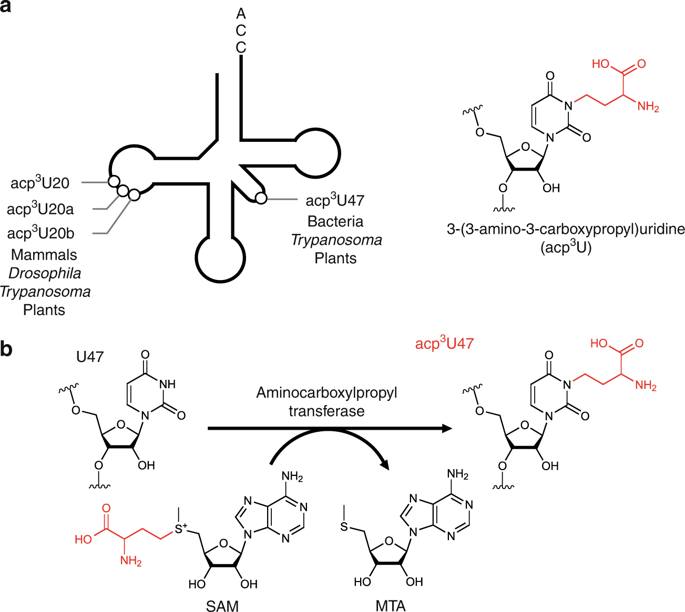当前位置:
X-MOL 学术
›
Nat. Commun.
›
论文详情
Our official English website, www.x-mol.net, welcomes your feedback! (Note: you will need to create a separate account there.)
Biogenesis and functions of aminocarboxypropyluridine in tRNA.
Nature Communications ( IF 14.7 ) Pub Date : 2019-12-05 , DOI: 10.1038/s41467-019-13525-3 Mayuko Takakura 1 , Kensuke Ishiguro 1 , Shinichiro Akichika 1 , Kenjyo Miyauchi 1 , Tsutomu Suzuki 1
Nature Communications ( IF 14.7 ) Pub Date : 2019-12-05 , DOI: 10.1038/s41467-019-13525-3 Mayuko Takakura 1 , Kensuke Ishiguro 1 , Shinichiro Akichika 1 , Kenjyo Miyauchi 1 , Tsutomu Suzuki 1
Affiliation

|
Transfer (t)RNAs contain a wide variety of post-transcriptional modifications, which play critical roles in tRNA stability and functions. 3-(3-amino-3-carboxypropyl)uridine (acp3U) is a highly conserved modification found in variable- and D-loops of tRNAs. Biogenesis and functions of acp3U have not been extensively investigated. Using a reverse-genetic approach supported by comparative genomics, we find here that the Escherichia coli yfiP gene, which we rename tapT (tRNA aminocarboxypropyltransferase), is responsible for acp3U formation in tRNA. Recombinant TapT synthesizes acp3U at position 47 of tRNAs in the presence of S-adenosylmethionine. Biochemical experiments reveal that acp3U47 confers thermal stability on tRNA. Curiously, the ΔtapT strain exhibits genome instability under continuous heat stress. We also find that the human homologs of tapT, DTWD1 and DTWD2, are responsible for acp3U formation at positions 20 and 20a of tRNAs, respectively. Double knockout cells of DTWD1 and DTWD2 exhibit growth retardation, indicating that acp3U is physiologically important in mammals.
中文翻译:

tRNA中氨基羧丙基尿苷的生物发生和功能。
转移(t)RNA包含多种转录后修饰,它们在tRNA稳定性和功能中起关键作用。3-(3-氨基-3-羧丙基)尿苷(acp3U)是在tRNA的可变环和D环中发现的高度保守的修饰。acp3U的生物发生和功能尚未得到广泛研究。使用比较基因组学支持的反向遗传方法,我们在这里发现大肠杆菌yfiP基因(我们将其重命名为tapT(tRNA氨基羧丙基转移酶))负责tRNA中acp3U的形成。重组TapT在S-腺苷甲硫氨酸存在下在tRNA的47位合成acp3U。生化实验表明,acp3U47赋予tRNA热稳定性。奇怪的是,ΔtapT菌株在连续的热胁迫下表现出基因组的不稳定性。我们还发现,tapT,DTWD1和DTWD2的人类同源物分别负责tRNA的20和20a处的acp3U形成。DTWD1和DTWD2的双敲除细胞表现出生长迟缓,表明acp3U在哺乳动物中具有重要的生理意义。
更新日期:2019-12-05
中文翻译:

tRNA中氨基羧丙基尿苷的生物发生和功能。
转移(t)RNA包含多种转录后修饰,它们在tRNA稳定性和功能中起关键作用。3-(3-氨基-3-羧丙基)尿苷(acp3U)是在tRNA的可变环和D环中发现的高度保守的修饰。acp3U的生物发生和功能尚未得到广泛研究。使用比较基因组学支持的反向遗传方法,我们在这里发现大肠杆菌yfiP基因(我们将其重命名为tapT(tRNA氨基羧丙基转移酶))负责tRNA中acp3U的形成。重组TapT在S-腺苷甲硫氨酸存在下在tRNA的47位合成acp3U。生化实验表明,acp3U47赋予tRNA热稳定性。奇怪的是,ΔtapT菌株在连续的热胁迫下表现出基因组的不稳定性。我们还发现,tapT,DTWD1和DTWD2的人类同源物分别负责tRNA的20和20a处的acp3U形成。DTWD1和DTWD2的双敲除细胞表现出生长迟缓,表明acp3U在哺乳动物中具有重要的生理意义。







































 京公网安备 11010802027423号
京公网安备 11010802027423号